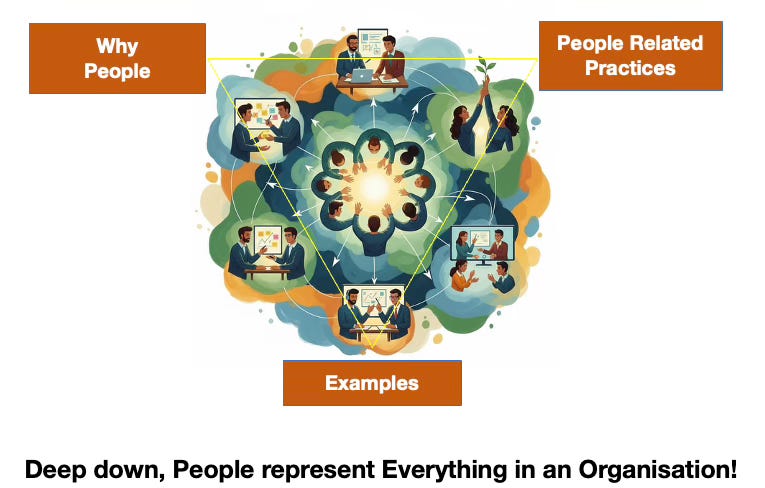From Concept to Care
Wholeness becomes real not through declarations of “bring your whole self to work,”
but through practices that make such presence safe. Every interaction — a feedback exchange, a one-on-one, a hiring conversation — is a moment when the system either invites or denies humanity.
People-related practices are therefore not HR routines; they are cultural technologies for enabling life to flow through people. They answer a single question:
What kind of organisational soil allows human beings to unfold naturally?
The Developmental View of People
Mechanistic organisations see people as roles. Alive Organisations see them as evolving consciousnesses — dynamic centres of perception, meaning, and creativity.
This changes everything:
Recruitment becomes discernment of potential.
Performance management becomes partnership in growth.
Leadership becomes stewardship of development.
The goal is no longer to “fit people into roles” but to grow roles around people’s unfolding capacities.
The Core Principles
There are several guiding principles for People-Related Practices which represent the laws of wholeness in motion:
Psychological Safety Is the Ground
– People must feel free to be authentic without fear of retribution.
– Safety precedes creativity; without it, aliveness contracts.Authenticity Is the Expression
– The invitation is not to perform roles but to inhabit them truthfully.
– Truth-telling becomes a shared norm, not a heroic act.Self-Fulfilment Is the Outcome
– The ultimate measure of success is inner growth expressed as contribution.Learning Is Continuous
– Every project doubles as a learning container.
– Curiosity replaces compliance as the core competence.Diversity Is Consciousness
– Diversity is not a metric but a field of intelligence.
– The system learns faster when multiple realities converse.
1. The Practice of Developmental Conversations
At the heart of People-Related Practices lies the developmental conversation — a dialogue that looks not only at results, but at the meaning-making behind results.
A developmental conversation asks:
What assumptions shaped your decisions?
How is this experience inviting you to grow?
Which part of you is learning to let go?
This practice turns management into mentorship and feedback into transformation.
Every conversation becomes a mirror through which both parties expand awareness.
When performed regularly, developmental dialogue becomes the organisation’s primary learning metabolism.
2. The Practice of Role Fluidity
In Alive Organisations, roles are not cages; they are containers for purpose.
As people grow, roles morph. This demands governance systems that make role change easy — not months of HR forms, but short sensing cycles where teams adjust accountabilities according to energy and capability.
Role fluidity ensures that the organisation’s structure evolves with its people, not against them. It embodies the metamorphic principle: adaptation as normality.
3. The Practice of Transparent Performance
Performance conversations in living systems are grounded in transparency and shared intention. Rather than annual reviews driven by metrics, teams adopt continuous performance dialogues: frequent, peer-involved reflections on contribution, learning, and purpose alignment.
Three core questions guide them:
What value did we co-create?
What did we learn about ourselves and our system?
What wants to change in our way of working?
This practice replaces anxiety with accountability and evaluation with evolution.
4. The Practice of Peer Coaching and Mentorship
Growth accelerates when learning circulates laterally. Peer coaching pairs colleagues across teams to support reflection and experimentation.
The structure is simple: e.g. one hour per month, rotating pairs, guided by appreciative inquiry questions such as:
What went well?
What challenged you most?
What’s your learning edge right now?
Over time, this builds a network of mutual growth where leadership is shared and learning becomes contagious.
5. The Practice of Recruiting for Potential
Alive Organisations recruit not only for skills but for developmental potential — the capacity to learn, reflect, and self-author. Interviews shift from technical interrogation to developmental dialogue:
“Tell us about a time your worldview changed. What helped it expand?”
Such questions reveal a candidate’s readiness for growth. Hiring for consciousness creates a population capable of sustaining aliveness; it turns recruitment into cultural design.
6. The Practice of Celebrating Humanity
In Whole Being cultures, celebration is not superficial; it is acknowledgement of aliveness itself. Milestones, gratitude circles, learning stories — all remind people that work is more than output; it is participation in a shared journey.
Celebration functions as emotional metabolism — transforming effort into meaning.
The Ripple Effects of People-Related Practices
When these practices take root, predictable transformations follow:
Belonging deepens - People feel seen, not just evaluated.
Engagement becomes intrinsic - Motivation flows from curiosity and care, not control.
Conflict softens - Differences become sources of insight rather than division.
Leadership multiplies - Everyone leads from their role; formal leaders become gardeners of capacity.
Performance stabilises - Learning cycles replace crisis cycles.
The culture becomes self-healing because people are no longer protecting themselves from it.
Integrating with the Pillars
Each of the Four Pillars finds expression here:
People practices are the point where all four pillars touch human experience — the bridge from thinking/being to acting.
A Living Definition
People-Related Practices are the daily disciplines through which an organisation cultivates the wholeness, growth, and authenticity of its members — ensuring that work becomes a field for human evolution rather than exhaustion.
They remind us that no organisation can be more alive than the people within it.
Bridge to the Next Chapter
Once human wholeness becomes habitual, it naturally extends outward. The same principles that govern internal collaboration begin to shape how the organisation interacts with partners, clients, and society.
That is the domain of the next chapter — 3.2 Value Co-Creation Practices — where relationship itself becomes the main engine of value and learning.
Enjoy reading and applying these content. If you’d like to receive additional information regarding Alive Organisations topic please subscribe below.



